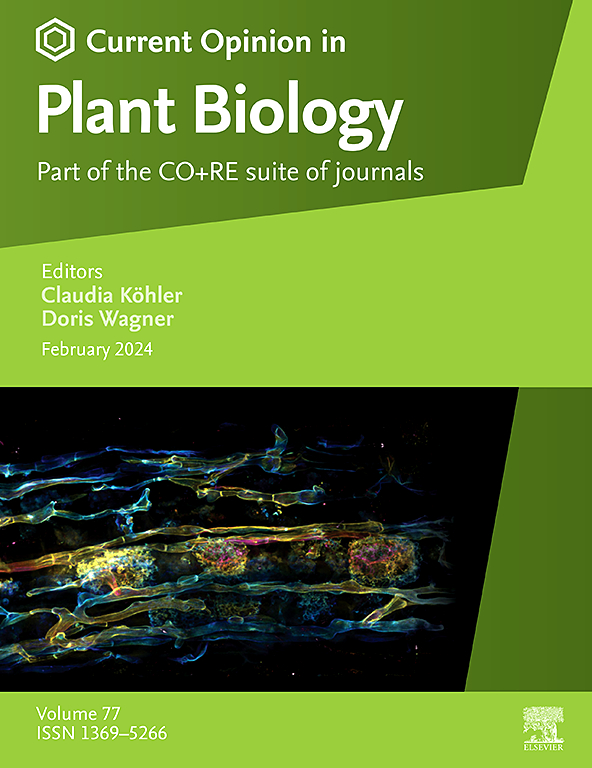Current insights into plant volatile organic compound biosynthesis
IF 7.5
2区 生物学
Q1 PLANT SCIENCES
引用次数: 0
Abstract
Plant-derived volatile organic compounds (VOCs) are essential for various ecological interactions, including plant communication, pollinator attraction, and defense against herbivores. Some VOCs are active ingredients with significant economic and medicinal value. For example, monoterpenoids such as linalool, geraniol, menthol, camphor, borneol, citral, and thymol are well-known for their flavor and aroma. Most monoterpenoids have a strong scent and physiological activity; some compounds, like thymoquinone, have excellent anti-cancer activities, making them important for pharmaceuticals and also beneficial in food and cosmetics. VOCs encompass a diverse range of chemical classes, such as terpenoids, benzenoids/phenylpropanoids, amino acid derivatives, and fatty acid-derived compounds. With the development of genomic, transcriptomic, and metabolomic techniques, significant progress has been made in the discovery of genes for the biosynthesis of VOCs. Herein, recent advances in the biosynthesis of plant-derived VOCs, focusing on two main classes: benzenoids/phenylpropanoids and monoterpenes, are discussed. It highlights the identification of a peroxisomal enzyme, benzaldehyde synthase, in petunia that elucidates the biosynthetic pathway of benzaldehyde, and a bifunctional enzyme, geranyl/farnesyl diphosphate synthase (RcG/FPPS1), in roses (Rosa chinensis “Old Blush”) that contributes to the production of cytosolic geranyl diphosphate. Current understanding about canonical and non-canonical pathways for monoterpene formation and some approaches that are useful for gene discovery have been discussed. Open questions and future perspectives in this field have also been presented.

植物挥发性有机化合物生物合成的最新进展
植物源性挥发性有机化合物(VOCs)在多种生态相互作用中发挥着重要作用,包括植物交流、吸引传粉者和抵御食草动物。有些挥发性有机化合物是具有重要经济和药用价值的活性成分。例如,单萜类化合物,如芳樟醇、香叶醇、薄荷醇、樟脑、冰片、柠檬醛和百里香酚,因其风味和香气而闻名。大多数单萜类化合物具有强烈的气味和生理活性;有些化合物,如百里醌,具有出色的抗癌活性,这使得它们在制药中很重要,在食品和化妆品中也很有益。挥发性有机化合物包括多种化学类别,如萜类、苯类/苯丙类、氨基酸衍生物和脂肪酸衍生化合物。随着基因组学、转录组学和代谢组学技术的发展,VOCs生物合成基因的发现取得了重大进展。本文综述了植物源性挥发性有机化合物生物合成的最新进展,重点介绍了两大类:苯类化合物和单萜化合物。研究人员在矮牵牛花中发现了一种过氧化物酶,即苯甲醛合成酶,该酶阐明了苯甲醛的生物合成途径;在玫瑰(Rosa chinensis“Old Blush”)中发现了一种双功能酶,即香叶基/法尼基二磷酸合成酶(RcG/FPPS1),该酶有助于胞质香叶基二磷酸的产生。目前对单萜烯形成的规范和非规范途径的理解以及一些对基因发现有用的方法进行了讨论。还提出了该领域的开放性问题和未来展望。
本文章由计算机程序翻译,如有差异,请以英文原文为准。
求助全文
约1分钟内获得全文
求助全文
来源期刊

Current opinion in plant biology
生物-植物科学
CiteScore
16.30
自引率
3.20%
发文量
131
审稿时长
6-12 weeks
期刊介绍:
Current Opinion in Plant Biology builds on Elsevier's reputation for excellence in scientific publishing and long-standing commitment to communicating high quality reproducible research. It is part of the Current Opinion and Research (CO+RE) suite of journals. All CO+RE journals leverage the Current Opinion legacy - of editorial excellence, high-impact, and global reach - to ensure they are a widely read resource that is integral to scientists' workflow.
 求助内容:
求助内容: 应助结果提醒方式:
应助结果提醒方式:


